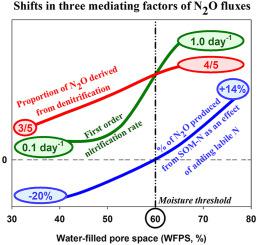Soil Biology and Biochemistry ( IF 9.7 ) Pub Date : 2021-02-04 , DOI: 10.1016/j.soilbio.2021.108166 Shakila K. Thilakarathna , Guillermo Hernandez-Ramirez

|
Nitrogen-fertilized agricultural soils are major emitters of the potent greenhouse gas nitrous oxide (N2O). Although soil moisture is known to drive N2O production, the influence of moisture on the priming effects of labile N additions, which alter the N2O production from native soil organic matter (SOM), remains understudied. We investigated how moisture impacts N2O primings, nitrification kinetics, and allocation of N2O sources between nitrification and denitrification. We evaluated urea additions at five water-filled pore spaces (WFPS): 31, 41, 53, 65, and 78%. Based on δ15N–N2O site preference (SP), the denitrification source (encompassing bacterial- and nitrifier-denitrification) amply dominated across all moistures. At moistures >60% WFPS, SP exhibited a narrow range of 1.2–1.6‰, whereas at 31% WFPS, SP rose to 9.4‰ (P < 0.001). These SPs translated into denitrification sourcing consistently four-fifth of the N2O production in the wettest soils. With drier soils, denitrification gradually decreased, but it still produced three-fifth of the N2O even at the driest soil (31% WFPS). Based on time courses of ammonium and nitrate concentrations, first-order kinetics (k1) modelling showed much slower nitrification rates at 31% WFPS (0.1 day−1) than the peak nitrification witnessed consistently at both 65 and 78% WFPSs (1.0 day−1). By using isotopically-labelled urea, we further allocated N2O production into SOM-N and urea-N sources. In soils receiving urea, SOM-N contribution to N2O production changed from being 77% in the driest soils to 46% in the wettest soil. Along this aeration-to-moisture gradient, net N2O priming steadily switched from being negative (−20%) in the driest soils to become positive (+14%) at the wettest soil, and this shifting trajectory intercepted the neutral 0% priming at 60% WFPS. Results indicate that pulse N2O emissions commonly reported in recently N-fertilized fields are triggered by soil moisture surpassing this threshold, which collectively accelerates positive primings of SOM and denitrification.
中文翻译:

土壤有机质的引发和反硝化作用介导了水分对一氧化二氮生产的影响
氮肥农业土壤是强效温室气体一氧化二氮(N 2 O)的主要排放者。尽管已知土壤水分会驱动N 2 O的产生,但是仍然需要研究水分对不稳定的N添加物的引发作用的影响,这些元素改变了天然土壤有机质(SOM)的N 2 O产生量。我们研究了水分如何影响N 2 O引发,硝化动力学以及硝化和反硝化之间N 2 O源的分配。我们评估了五个充水孔隙空间(WFPS)的尿素添加量:31%,41%,53%,65%和78%。基于δ 15 N-N 2在站点偏好(SP)中,反硝化源(包括细菌和硝化剂的反硝化作用)在所有水分中占主导地位。水分> 60%WFPS时,SP表现出1.2-1.6‰的窄幅变化,而水分含量> 31%WFPS时,SP上升至9.4‰(P <0.001)。这些SP转化为反硝化作用,在最湿的土壤中始终产生五分之四的N 2 O产量。在较干燥的土壤中,反硝化作用逐渐降低,但即使在最干燥的土壤(31%WFPS)下,N 2 O仍产生五分之三。基于铵盐和硝酸盐浓度的时程,一阶动力学(k 1)模型显示在31%WFPS时(0.1天−1时)硝化速率要慢得多),则在65%和78%的WFPS(1.0天-1)下,硝化峰值始终如一。通过使用同位素标记的尿素,我们进一步将N 2 O产量分配到SOM-N和尿素N来源中。在接受尿素的土壤中,SOM-N对N 2 O产生的贡献从最干燥的土壤的77%变为最湿的土壤的46%。沿着该通气-湿度梯度,净N 2 O灌注从最干燥的土壤中的负(-20%)稳定地切换为最湿的土壤中的正(+ 14%),并且该移动轨迹截取了中性0%以60%的WFPS启动。结果表明脉冲N 2近来氮肥田间普遍报告的O排放是由土壤水分超过该阈值触发的,这共同加速了SOM和反硝化的积极启动。


























 京公网安备 11010802027423号
京公网安备 11010802027423号